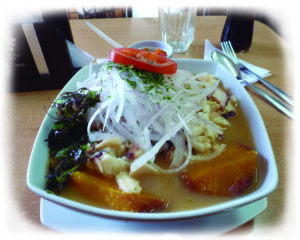Over the next few weeks we are going to be uploading several articles on Spanish and Latin American culture, which will include insights for the intrepid traveller. We’ll also include pieces on travel Spanish and how they relate to cultural interactions! First up is an article relating to the title of this blog post. Stay tuned for much more!
Download the pdf version of cuisine & the food-savvy traveller in Spain & Latin America: Part 1
Cuisine & the Food-Savvy Traveller in Spain & Latin America: Part 1
Food in Spain has been influenced by a number of different peoples over the centuries. Perhaps the greatest early influence came from the Moors (an archaic term used to refer to Arabs, North Africans and other groups), who invaded the Iberian Peninsula in 711. One of their greatest legacies in cuisine is perhaps their light seasonings such as the quintessential saffron (azafrán), rice (arroz), both found in paella, as well as the introduction of fruits and nuts into meat and fish dishes such as conejo con salsa de almendras (rabbit with almond sauce). A lot of food in Spain and indeed other major parts of the world has been greatly influenced by ingredients from the Americas. Tomatoes, quinoa and cacao were all brought back from the New World and incorporated into Spanish, and indeed world cuisine. These classic world-famous staples require no examples!
A lot of food in Latin America has experienced a similar evolution. Indigenous people have lived in the Americas for 13,500 years – possibly a lot longer – and foods which they have cultivated and continue to cultivate form the basis for many dishes (indigenous and non-indigenous) in the region. Examples include the corn found in tortillas in Mexico and Central America, the plantain from the fried snack or accompaniment known as patacones or tostones found all over the Americas, and of course the humble potato (papa) and its million variants found in Peruvian dishes such as ceviche, a dish of raw fish marinated in lemon juice and papas a la huancaína, a potato-laden dish with a tasty sauce. Europeans arrived in the Americas from 1492 onwards, and they influenced a lot of the early forms of Latin American cuisine. For instance, in Mexico, the early European presence contributed a lot of cooking techniques such as frying. The new arrivals also introduced a number of ingredients to the continent, such as the onions found in ají, a Colombian hot sauce (as well as in countless other dishes), and various spices such as cumin (comino), which can be found in numerous Colombian and Mexican dishes. Finally, what summary of the history of Hispanic food would be complete without addressing the influence of contemporary western food on these diets? Fast food has influenced a range of foods in Latin America, from arroz con coca cola (rice with Coca Cola!) in Colombia, to the range of large multinational companies such as McDonald’s, and even smaller, local interpretations of typical fast food such as the Guatemalan-formed fried chicken restaurant, pollo campero, which can be found all over Latin America. So there you have it: who could imagine a Spanish paella without the Moor and New World-influenced rice, tomatoes or saffron? Or a Mexican chilli con carne without the indigenous influenced tortillas and the onions and spices of Europe and Africa? And who could imagine a plantain without the oil used to make a delicious patacón! Next up, traditional foods and customs in Spain and Latin America…
What are your experiences with Spanish and Latin American Culture and the food that it offers? What are your experiences with the cuisine and how it differed from country to country? Leave your comments below – we welcome your contributions!

